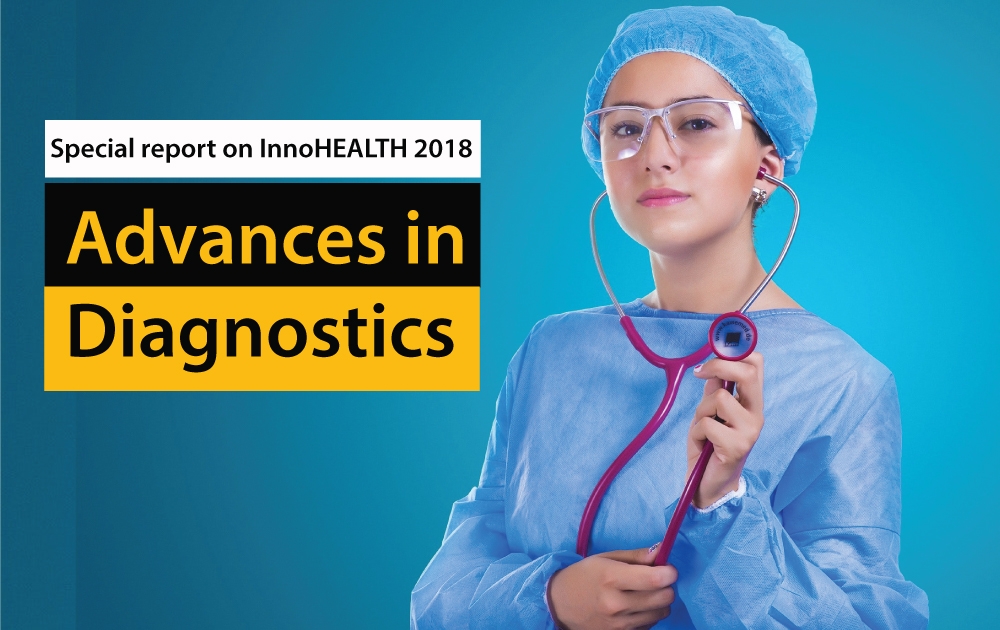Another area of interest throughout the InnoHEALTH 2018 conference was the Advances in Diagnostics. As one hand it brings the top industry leaders sharing their vision, where the sector is moving, on the other hand, the most promising startups and technologies. It provided a soft landing space where the top leaders were able to provide a pathway for the best ideas to be supported and overall improving the state of the health sector in the country.
The panel represents various industry working in cutting-edge research in radiology and diagnostics areas from India and Sweden.
(Hony) Brigadier Dr Arvind Lal with his keynote address described that only 10% of overall healthcare constituents diagnosis.He discussed the emerging trends in Diagnostics by putting forward four questions
- What is happening in healthcare?
- How will that affect us as pathologists?
- What are the emerging technologies?
- What can you do to better prepare yourself?
[vc_single_image image=”4828″ img_size=”500×300″ alignment=”center” onclick=”link_image”]
Many trends relate to technological advances & the necessity to increase quality & efficiency. The new factor for the IVD industry, not previously seen, is the influence of educated & informed healthcare consumers. Clinical lab testing is one of the greatest bargains in healthcare but often draws the attention from cost-cutters. Lab professionals also will increasingly capitalize on these emerging opportunities & options.
The whole paradigm of healthcare is shifting and will continue to shift—from technological advances like electronic health records. This will change the historic doctor/patient relationship marking the onset of an era of patient empowerment in which the patient shall become more responsible for maintaining good health.
The Healthcare sector, in India, is at an inflection point and is poised for rapid growth At a CAGR of 21% – we will have an industry of 300 billion US $ by 2020. A combination of demographic and economic factors is expected to drive the growth of the sector.
The main points addressed the need to use the emerging trends in diagnostics such as
- Wellness Health Model – the power of diagnostics to change the focus of healthcare from treating sickness to promoting wellness
- The rise of the corporation – Consolidation & Automation
- Role of PPP in Rural Healthcare – a private-private partnership
- Need for Accreditation – Quality of samples and testing
- Consumer-centric healthcare – Handheld devices and POC (Point of Care) testing
- Growing in Digitisation
Dr. Ravi Gaur wanted the healthcare facilities available in metro cities should reach the remote areas too, that’s where innovations in diagnosis should take us. Dr. Vidur Mahajan’s company validates clinical test with their expertise and team of researches.
“Simple solutions for complex problems” is the lateral thinking behind Pawan Asalapuram who is currently working on eradication of TB in the country by his innovations in diagnosis methods. Use of his product, PCR, TB can be recognized in just 90 mins which usually takes 3 to 6 months.
[vc_single_image image=”4830″ img_size=”500×400″ alignment=”center” onclick=”link_image”]
Dr. Richa Dayal suggested continuous monitoring devices. She then spoke on the data analysis part, where the study shows that India is researching on the data outsourced instead of self-published data as we lack in data. She demanded the support of policymakers in the area of diagnostics.
Mr. Anoop Shaji, final year undergraduate student He has delivered dozens of award-winning scientific presentations at various international, national scientific meets on his original novel, indigenously developed, potentially promising conceptual models. Anoop Shaji was the only dental student selected among 160 students all over India from all UG streams to be invited as a delegate to first ever Nobel prize series in connection to vibrant Gujarat 2017, which was presided by 9 Nobel laureates and the prime minister of India for conceptually developing a potential breakthrough for brain cancer treatment.
He became the voice of the young innovators in the conference and emphasized on POC (point of care) diagnosis. His current work is on a simple device detection of cancer with just one single drop of blood. Lab on the chip would be a boon in advancements in diagnostics and insisted on continuous efforts on it along with the financial and legal support.


Before reading this I have no enough knowledge in this field, but you have provided such a wonderful information for diagnostics it’s very useful. Thanks for sharing a useful content with us. Keep sharing.